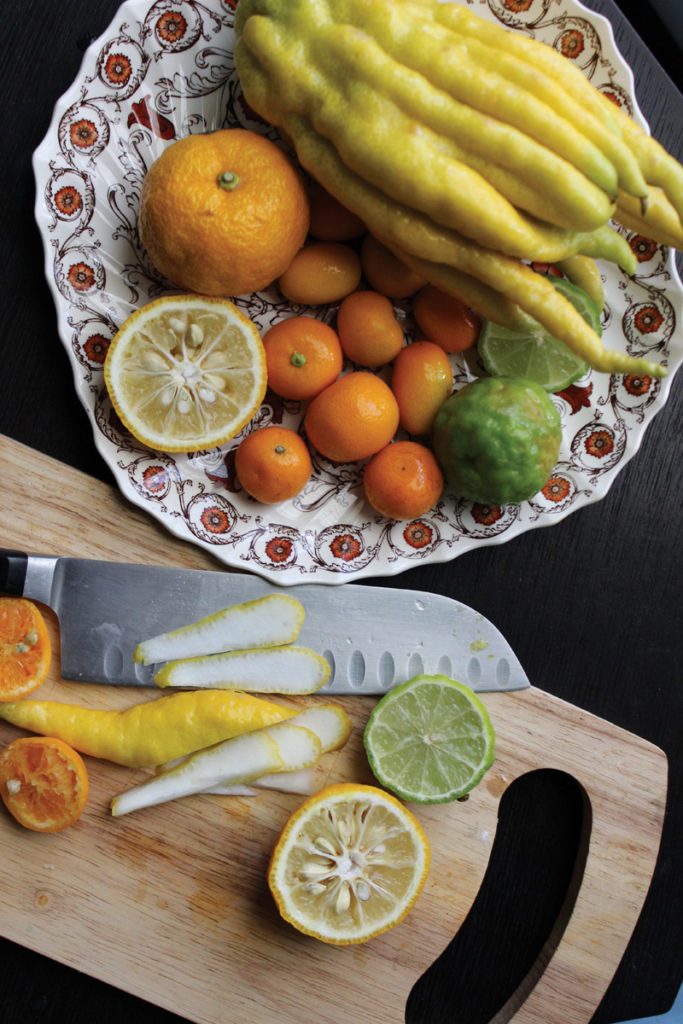After the holidays comes the seemingly endless expanse of winter. One can easily settle into a routine of carrots, broccoli, apples and bananas for meals. Not only is a limited diet monotonous, it is not good for your health. You gain more nutritional value from a varied diet of colorful produce.
As a low-calorie option that also provides high levels of soluble fiber, winter vegetables and fruits also fill you up and prevent the release of ghrelin, the “hunger” hormone. Nutrient-dense choices can significantly reduce snacking between meals and help with clean eating resolutions.
Usher in the new year trying unusual fruits and vegetables that are in season — here are eight to try.
Celeriac or celery root is another name for the large edible root of the celery plant specially cultivated for this use. Its flavor is a cross between celery and parsley. Celery root stores well at cool temperatures and is readily available throughout the winter.
Shop for firm, unblemished roots that feel heavy for their size and store in the refrigerator unpeeled and wrapped in a dry paper towel to absorb excess moisture in an unsealed bag. Stored properly, celeriac will keep for up to three weeks. To prepare, scrub celery roots well, then trim the top and bottom with a sharp knife. Peel skin with a vegetable peeler and remove any pocked parts of the root with a sharp paring knife.
The roots roast well and can be paired with other root vegetables. Try making roasted celery root and Yukon Gold potatoes with honey and rosemary. Cut the vegetables into half-inch dice, toss in olive oil and salt, and roast on a sheet pan at 425 F. until browned and tender. Dress lightly with a combination of melted butter, honey and chopped fresh rosemary.
The rutabaga is a root vegetable that is a hybrid between the cabbage and the turnip. Both turnips and rutabagas are members of the cabbage family. Rutabagas first appeared in North America around 1817, grown in Illinois.
Turnips are usually white or white and purple, while rutabagas are usually yellowish and brown, with rutabagas slightly sweeter than turnips. Turnips are typically harvested when small and tender, while rutabagas stay tender even at larger sizes. As with many vegetables, turnips or rutabagas should be chosen based on their firmness and whether they feel a bit heavy for their size.
Rutabagas come coated with a layer of wax to prevent them from losing moisture and drying out. Cut the rutabaga in half, then peel with a sturdy Y-shaped vegetable peeler. Both rutabagas and turnips can be roasted or cooked in casseroles or stews. Rutabaga is also an excellent addition to mashed potatoes after it is boiled and mashed. For tasty oven-roasted fries toss rutabaga spears in olive oil and season with salt and seasonings of your choice, then roast at 425 F. for 30 minutes until tender.
Parsnips, an easy-to-prepare root vegetable, are closely related to the carrot and parsley. They are sweet like carrots but starchy like potatoes. Like beets, parsnips were used as a sweetening agent for foods before cane sugar became a major import to Europe. When shopping, choose white parsnips — the whiter the flesh, the sweeter the parsnip. Select smaller roots that are firm and intact and avoid those that are yellowing or going brown around the core. Wash and peel them like carrots, then prepare as you would carrots or potatoes.
Try dicing peeled parsnips and coat lightly with olive oil and salt. Roast at 425 F. for 30 minutes, then coat with a melted mixture of equal parts butter, white miso paste and maple syrup. Broil (watch carefully!) for a few minutes, turning the pieces once or twice until evenly glazed.
Specialty citrus like Buddha’s hand, Makrut limes, yuzu lemons and kumquats are available when they are in season during the winter months. If using the rind of the fruit, be sure to purchase organic produce to avoid pesticides. These specialty citrus trees can also be grown in large containers on wheels in San Antonio. During rare extended freezes, roll the containers into a protected area and cover the entire plant with blankets.
Buddha’s hand looks like an alien claw, but this citrus fruit has no juice or pulp. It has a sweet, lemon blossom aroma and a mild-tasting pith that is not bitter. The fruit can be zested or used whole. Try shaving thin slices of Buddha’s hand for a salad or use it to top steamed fish. It can also be zested and mixed in to flavor sugar or salt, as Buddha’s hand citron is a great substitute for most recipes calling for citrus zest. This creepy-looking lemon hand can also be candied; homemade candied citron can be added to holiday bread and cake recipes.
A great way to dress a winter salad is with a citron vinaigrette — try it with a salad of radishes and bitter greens like arugula and frisee. Add four parts good-quality olive oil, two parts lemon juice and one part balsamic vinegar to some salt and Buddha’s hand zest in a sealed jar and mix well.
Makrut limes and their leaves are used in Thai cooking and have a clean, slightly woodsy fragrance. The zest of the lime is a key ingredient in red and green curry pastes, while its leaves are fragrant and thick, dark green and shiny on the top.
Try making your favorite flan or panna cotta recipe using coconut milk instead of milk and several torn Makrut lime leaves steeped in the milk. The unique flavor of lime leaves makes for an addictive, memorable treat!
Yuzu is a Japanese lemon that is valued for its highly aromatic rind. It is also one of the few citrus fruits that maintains its tart flavor at high cooking temperatures. Like the Buddha’s hand, yuzu is also a citron, meaning its juice is minimal and, as a result, expensive. Fragrant with an intense aroma, yuzu has a mix of flavors between a classic sweet lemon and a tart grapefruit.
Yuzu is used in Japanese cuisine and is an essential ingredient of Japanese ponzu sauce as well as yuzu-kosho, a spicy chili-salt made with yuzu zest. You can try making your own with a quality sea salt, finely grated fresh yuzu lemon zest and a touch of chili. It livens the flavor of everything from seafood to chicken, soups and roasted vegetables.
Kumquats have a short winter season, but are so worth their bright, sweet-tart citrus flavor. Always choose bright, plump kumquats without blemishes or spots. They do not have much of an aroma, but their peels should look shiny. Look for organically grown kumquats, and keep cool in the refrigerator for several days if not using immediately. Kumquats have a thinner peel and thus a shorter shelf life.
Use kumquats whole, peel and all. Their tiny seeds are edible, and the peel is much sweeter than its juice. The secret to easy kumquat marmalade or relish is cutting off the top and squeezing out the sour juice and small seeds. The resulting marmalade is both precious and gift-worthy.
Resources
Collection of healthy winter vegetable and fruit recipes: http://www.cookinglight.com/food/top-rated-recipes/best-recipes-winter-vegetables-fruits#winters-best-pasta-black-kale-caramelized-onions-parsnips
Recipe for candied Buddha’s hand: https://www.davidlebovitz.com/candied-citron-recipe/
Recipe using Makrut lime leaves: https://www.yummly.com/#recipe/Healthier-Red-Thai-Chicken-Curry—without-the-shop-bought-sauce_-2035928
Story and Photography by Iris Gonzalez










0 Comments